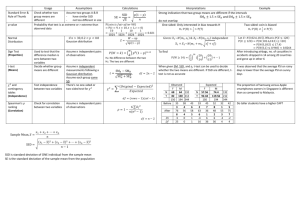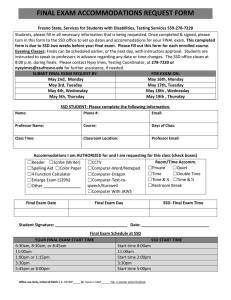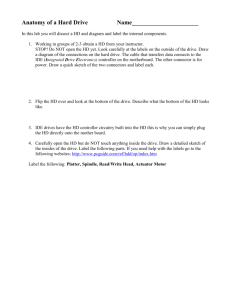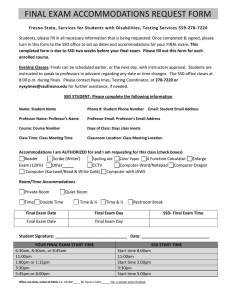Document 13199769
advertisement
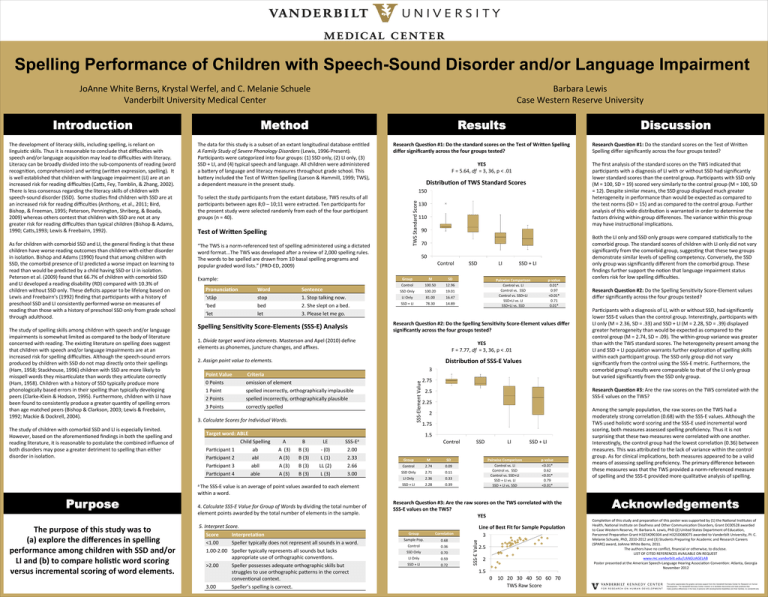
Spelling Performance of Children with Speech-Sound Disorder and/or Language Impairment JoAnne White Berns, Krystal Werfel, and C. Melanie Schuele Vanderbilt University Medical Center Barbara Lewis Case Western Reserve University Method Results Discussion The development of literacy skills, including spelling, is reliant on linguisGc skills. Thus it is reasonable to conclude that difficulGes with speech and/or language acquisiGon may lead to difficulGes with literacy. Literacy can be broadly divided into the sub-­‐components of reading (word recogniGon, comprehension) and wriGng (wri>en expression, spelling). It is well established that children with language impairment (LI) are at an increased risk for reading difficulGes (Ca>s, Fey, Tomblin, & Zhang, 2002). There is less consensus regarding the literacy skills of children with speech-­‐sound disorder (SSD). Some studies find children with SSD are at an increased risk for reading difficulGes (Anthony, et al., 2011; Bird, Bishop, & Freeman, 1995; Peterson, Pennington, Shriberg, & Boada, 2009) whereas others contest that children with SSD are not at any greater risk for reading difficulGes than typical children (Bishop & Adams, 1990; Ca>s,1993; Lewis & Freebairn, 1992). As for children with comorbid SSD and LI, the general finding is that these children have worse reading outcomes than children with either disorder in isolaGon. Bishop and Adams (1990) found that among children with SSD, the comorbid presence of LI predicted a worse impact on learning to read than would be predicted by a child having SSD or LI in isolaGon. Peterson et al. (2009) found that 66.7% of children with comorbid SSD and LI developed a reading disability (RD) compared with 10.3% of children without SSD only. These deficits appear to be lifelong based on Lewis and Freebairn’s (1992) finding that parGcipants with a history of preschool SSD and LI consistently performed worse on measures of reading than those with a history of preschool SSD only from grade school through adulthood. The study of spelling skills among children with speech and/or language impairments is somewhat limited as compared to the body of literature concerned with reading. The exisGng literature on spelling does suggest that children with speech and/or language impairments are at an increased risk for spelling difficulGes. Although the speech-­‐sound errors produced by children with SSD do not map directly onto their spellings (Ham, 1958; Stackhouse, 1996) children with SSD are more likely to misspell words they misarGculate than words they arGculate correctly (Ham, 1958). Children with a history of SSD typically produce more phonologically based errors in their spelling than typically developing peers (Clarke-­‐Klein & Hodson, 1995). Furthermore, children with LI have been found to consistently produce a greater quanGty of spelling errors than age matched peers (Bishop & Clarkson, 2003; Lewis & Freebairn, 1992; Mackie & Dockrell, 2004). The study of children with comorbid SSD and LI is especially limited. However, based on the aforemenGoned findings in both the spelling and reading literature, it is reasonable to postulate the combined influence of both disorders may pose a greater detriment to spelling than either disorder in isolaGon. The data for this study is a subset of an extant longitudinal database enGtled A Family Study of Severe Phonology Disorders (Lewis, 1996-­‐Present). ParGcipants were categorized into four groups: (1) SSD only, (2) LI only, (3) SSD + LI, and (4) typical speech and language. All children were administered a ba>ery of language and literacy measures throughout grade school. This ba>ery included the Test of Wri>en Spelling (Larson & Hammill, 1999; TWS), a dependent measure in the present study. To select the study parGcipants from the extant database, TWS results of all parGcipants between ages 8;0 – 10;11 were extracted. Ten parGcipants for the present study were selected randomly from each of the four parGcipant groups (n = 40). Research Ques+on #1: Do the standard scores on the Test of Wri8en Spelling differ significantly across the four groups tested? YES F = 5.64, df = 3, 36, p < .01 Distribu+on of TWS Standard Scores 150 130 110 90 70 50 Control SSD LI SSD + LI Group M SD Pairwise Comparison p-­‐value Control 100.50 12.96 Control vs. LI 0.01* Control vs. SSD 0.97 SSD Only 100.20 19.01 Control vs. SSD+LI <0.01* LI Only 81.00 16.47 SSD+LI vs. LI 0.71 SSD + LI 78.30 14.89 SSD+LI vs. SSD 0.01* Research Ques+on #2: Do the Spelling Sensi+vity Score-­‐Element values differ significantly across the four groups tested? YES F = 7.77, df = 3, 36, p < .01 Distribu+on of SSS-­‐E Values 3 2.75 2.5 2.25 2 1.75 1.5 Control SSD LI SSD + LI Group M SD Pairwise Comparison p-­‐value Control vs. LI <0.01* Control 2.74 0.09 SSD Only Control vs. SSD 0.62 2.71 0.11 Control vs. SSD+LI <0.01* LI Only 2.36 0.33 SSD + LI vs. LI 0.79 SSD + LI 2.28 0.39 SSD + LI vs. SSD <0.01* Research Ques+on #3: Are the raw scores on the TWS correlated with the SSS-­‐E values on the TWS? YES Line of Best Fit for Sample Popula+on Group Correla+on 3 Sample Pop. 0.68 Control 0.36 2.5 SSD Only 0.70 LI Only 0.59 2 SSD + LI 0.72 1.5 0 10 20 30 40 50 60 70 TWS Raw Score Research Ques+on #1: Do the standard scores on the Test of Wri>en Spelling differ significantly across the four groups tested? The first analysis of the standard scores on the TWS indicated that parGcipants with a diagnosis of LI with or without SSD had significantly lower standard scores than the control group. ParGcipants with SSD only (M = 100, SD = 19) scored very similarly to the control group (M = 100, SD = 12). Despite similar means, the SSD group displayed much greater heterogeneity in performance than would be expected as compared to the test norms (SD = 15) and as compared to the control group. Further analysis of this wide distribuGon is warranted in order to determine the factors driving within-­‐group differences. The variance within this group may have instrucGonal implicaGons. Both the LI only and SSD only groups were compared staGsGcally to the comorbid group. The standard scores of children with LI only did not vary significantly from the comorbid group, suggesGng that these two groups demonstrate similar levels of spelling competency. Conversely, the SSD only group was significantly different from the comorbid group. These findings further support the noGon that language impairment status confers risk for low spelling difficulGes. Research Ques+on #2: Do the Spelling SensiGvity Score-­‐Element values differ significantly across the four groups tested? ParGcipants with a diagnosis of LI, with or without SSD, had significantly lower SSS-­‐E values than the control group. InteresGngly, parGcipants with LI only (M = 2.36, SD = .33) and SSD + LI (M = 2.28, SD = .39) displayed greater heterogeneity than would be expected as compared to the control group (M = 2.74, SD = .09). The within-­‐group variance was greater than with the TWS standard scores. The heterogeneity present among the LI and SSD + LI populaGon warrants further exploraGon of spelling skills within each parGcipant group. The SSD only group did not vary significantly from the control using the SSS-­‐E metric. Furthermore, the comorbid group’s results were comparable to that of the LI only group but varied significantly from the SSD only group. Research Ques+on #3: Are the raw scores on the TWS correlated with the SSS-­‐E values on the TWS? Among the sample populaGon, the raw scores on the TWS had a moderately strong correlaGon (0.68) with the SSS-­‐E values. Although the TWS used holisGc word scoring and the SSS-­‐E used incremental word scoring, both measures assessed spelling proficiency. Thus it is not surprising that these two measures were correlated with one another. InteresGngly, the control group had the lowest correlaGon (0.36) between measures. This was a>ributed to the lack of variance within the control group. As for clinical implicaGons, both measures appeared to be a valid means of assessing spelling proficiency. The primary difference between these measures was that the TWS provided a norm-­‐referenced measure of spelling and the SSS-­‐E provided more qualitaGve analysis of spelling. The purpose of this study was to (a) explore the differences in spelling performance among children with SSD and/or LI and (b) to compare holis+c word scoring versus incremental scoring of word elements. Spelling Sensi+vity Score-­‐Elements (SSS-­‐E) Analysis 1. Divide target word into elements. Masterson and Apel (2010) define elements as phonemes, juncture changes, and affixes. 2. Assign point value to elements. Point Value Criteria 0 Points omission of element 1 Point spelled incorrectly, orthographically implausible spelled incorrectly, orthographically plausible 2 Points correctly spelled 3 Points 3. Calculate Scores for Individual Words. Target word: ABLE Child Spelling A B LE SSS-­‐Ea ParGcipant 1 ab A (3) B (3) -­‐ (0) 2.00 abl A (3) B (3) L (1) 2.33 ParGcipant 2 abll A (3) B (3) LL (2) 2.66 ParGcipant 3 ParGcipant 4 able A (3) B (3) L (3) 3.00 a The SSS-­‐E value is an average of point values awarded to each element within a word. 4. Calculate SSS-­‐E Value for Group of Words by dividing the total number of element points awarded by the total number of elements in the sample. 5. Interpret Score. Score Interpreta+on <1.00 Speller typically does not represent all sounds in a word. 1.00-­‐2.00 Speller typically represents all sounds but lacks appropriate use of orthographic convenGons. >2.00 Speller possesses adequate orthographic skills but struggles to use orthographic pa>erns in the correct convenGonal context. 3.00 Speller’s spelling is correct. SSS-­‐Element Value “The TWS is a norm-­‐referenced test of spelling administered using a dictated word format...The TWS was developed ater a review of 2,000 spelling rules. The words to be spelled are drawn from 10 basal spelling programs and popular graded word lists.” (PRO-­‐ED, 2009) Example: Pronuncia+on Word Sentence stop 1. Stop talking now. ‘stāp ‘bed bed 2. She slept on a bed. ‘let let 3. Please let me go. SSS-­‐E Value Purpose Test of Wri8en Spelling TWS Standard Score Introduction Acknowledgements CompleGon of this study and preparaGon of this poster was supported by (1) the NaGonal InsGtutes of Health, NaGonal InsGtute on Deafness and Other CommunicaGon Disorders, Grant DC00528 awarded to Case Western Reserve, PI: Barbara A. Lewis, PhD (2) United States Department of EducaGon, Personnel PreparaGon Grant H325K090304 and H325D080075 awarded to Vanderbilt University, PI: C. Melanie Schuele, PhD, 2010-­‐2012 and (3) Students Preparing for Academic and Research Careers (SPARC) award, JoAnne White Berns, 2011. The authors have no conflict, financial or otherwise, to disclose. LIST OF CITED REFERENCES AVAILABLE ON REQUEST www.mc.vanderbilt.edu/LANGUAGELAB Poster presented at the American Speech-­‐Language Hearing AssociaGon ConvenGon: Atlanta, Georgia November 2012
